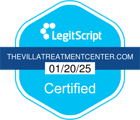Meth can be ingested in multiple different ways, from smoking and snorting to injecting. But no matter how it is consumed, meth changes the way the brain works. Once that change has taken place, it’s much more difficult to stop meth use or even reduce consumption of the drug, which can result in withdrawal symptoms. Let’s take a look at your options for safe meth withdrawal and treatment.
Safe Withdrawal & Detox
There’s no sugarcoating the fact that meth withdrawal is an unpleasant experience. Withdrawal from meth can set in no matter how much you use, whether it was a one-time use, a binge, or a full-blown addiction. It occurs when the brain is deprived of the dopamine chemicals generated by the drug and begins to revert back to its normal state.
Though withdrawal from meth can be managed safely, it can still pose risks to the person in recovery, including harmful side effects such as:
- Strong psychosis and becoming a danger to self or others
- Depression with suicidal thoughts
- Underlying psychological or health issues which arise and complicate withdrawal
The best way to approach the detox process is always to seek out the guidance and support of trained professionals, ideally in an inpatient setting.
Successful withdrawal from meth requires careful planning since the withdrawal process actually happens in two stages. Symptoms are most acutely felt during the initial stage of withdrawal that begins within 24 hours after the last meth dose.
One of the most common symptoms of meth withdrawal is hypersomnia, or excessive sleeping. People recovering from meth addiction can spend 11 hours or more per day asleep. This symptom usually peaks on the fifth day of withdrawal.
Luckily, most of these initial symptoms generally resolve themselves in one week on average and the intensity of symptoms begin to ease after two weeks.
The second phase of Meth withdrawal generally lasts up to three weeks, with more manageable symptoms like cravings. However, it’s not uncommon for meth users to experience withdrawal for more than three weeks. In fact, symptoms can persist for months.
These symptoms include a lack of interest in your surroundings, cravings for the drug, agitation, depression, decreased libido, emotional instability, excessive sleeping, paranoia, and night sweats.
Other symptoms may include:
- Anxiety
- Fatigue
- Increased appetite
- Insomnia
- Vivid and unpleasant dreams
Quitting Meth Cold Turkey
 What does quitting meth cold turkey mean? It’s stopping use of meth abruptly without any medical guidance or formal treatment plan. But is quitting meth cold turkey safe?
What does quitting meth cold turkey mean? It’s stopping use of meth abruptly without any medical guidance or formal treatment plan. But is quitting meth cold turkey safe?
Quitting meth cold turkey, that is, totally and all at once is the most difficult way to for an individual to quit, and it is likely that they will suffer extreme withdrawal symptoms which can even result in depression and psychosis. So what’s another way of quitting meth if cold turkey is too difficult?
Tapering is a well-known and highly recommended method of quitting. In tapering, the individual slowly reduces their dosage, instead of stopping all at once. This can minimize the severity of withdrawal symptoms. Addiction experts have different tapering techniques. An individual could cut back their drug use to a couple times a week rather than every day. Or they could reduce their daily doses.
Individuals who stop taking meth often can’t experience pleasure in life. This is a state called ‘anhedonia’. It is not a permanent state, but it is a big reason why medical supervision is required during withdrawal. This is also why there is a significant risk of relapse during meth withdrawal, because the individual can’t stand the way they feel.
As mentioned, meth is only minimally physically addictive. It does not cause many symptoms of physical dependence. However, psychological symptoms can be present and they can be severe. Depression is all too common and the individual coming off meth can tend to feel extremely depressed for a while, and also experience cravings. They will also tend to sleep a lot, either because they weren’t getting enough sleep while on meth, or due to the depression. Eating a lot is also quite usual, since the individual probably wasn’t eating enough, and now are using food as a replacement drug.
Some of the main risks of stopping meth cold turkey include:
- Suicidal tendencies
- High likelihood of relapse
- Psychotic symptoms
- Feeling hopeless
Safer Treatment Options
When you’re ready for treatment, the correct first step is always to consult a doctor who can help you determine how severe your symptoms are and prescribe a safe course of action for when withdrawal presents itself.
In addition to medical intervention, natural healing methods can help people through the withdrawal process. Alternative therapies such as acupuncture, nutritional supplements, and herbal remedies can help balance moods and regulate sleep. Exercise can help produce endorphins and stimulate the immune system and low-impact activities like yoga can help with relaxation.
The next step after you visit a doctor is to seek out a recovery expert who can help ensure a safe detox experience. During the initial detox phases, intervention by an experienced recovery professional is vital. When you move into treatment, they can help you with addiction therapy like 12 step recovery programs, community support, family education, skills development, psychological treatment, and psychotherapy.
Because of the severity of the drug, meth withdrawal and recovery is best managed in an inpatient facility where a trained staff can intervene throughout treatment.
Once you’ve completed your treatment and are ready to leave the inpatient treatment center, it’s important to re-enter everyday life in a supportive and welcoming environment. People at risk of relapse should avoid drug users and the places they may associate with their past meth abuse, as well as try to eliminate potential triggers from their lives.
Safe recovery and long-term sobriety from a meth addiction can only be achieved through constant vigilance and external support from people who care.






